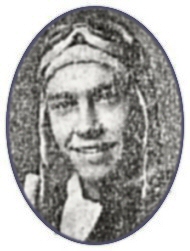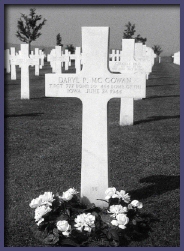Daryl P. McGowan
 |
 T/Sgt. Daryl McGowan's grave marker at the Lorraine American Cemetery in St. Avold (Moselle), France |
Daryl P. McGowan, 777th
26 June 1944
Daryl P. McGowan was born in Calhoun County, Iowa in 1921 to Mr. and Mrs. Paul McGowan. He completed 4 years of high school and later learned to operate trucks and tractors.
He enlisted in the U.S. Army Air Corps at Camp Dodge Herrold, Iowa on 5 Oct. 1942. He achieved the rank of Technical Sergeant and was an Engineer/Gunner in the 777th Squadron of the 464th Bombardment Group.
On 26 June 1944, during a mission to the Florisdorf Oil Refinery and Oil Sidings in Vienna, Austria, Daryl's aircraft, Yellow Z (42-50401), was hit by anti-aircraft fire and went down in flames. (MACR 6455.) He was declared Missing In Action.
On 14 Sept. 1944 Daryl's parents were notified that he had been awarded the Air Medal and the Distinguished Flying Cross for his gallantry and achievement of his many missions over enemy territory. Daryl was also awarded the Purple Heart. In a local newspaper interview his parents expressed the hope that he might yet be safe, somewhere.
The USAAC later declared that Daryl was killed in action on 26 June 1944 during his 39th mission.
After his death, Daryl's remains was buried in Plot B, Row 22, Grave 56 at the Lorraine American Cemetery in St. Avold (Moselle), France.
The Germans later released this report about Daryl McGowan's last mission.
One historical record cites the mission details as follows:
Florisdorf Oil Refinery and M/Y Oil Sidings at Vienna, mission flown on 26 June 1944.
This proved to be a very expensive mission for this group, both Colonel Marshall Bonner, Group Commanding Officer and Major Thomas J. Carter, Commanding Officer, 777th Bombardment Squadron (H) going down over the target area.
72 tons of 250 lb. clustered G.P. bombs were dropped on the target. Considerable damage was caused by our bombs, even though the percentage (.099% within 1000 feet and 36.8% within 2000 feet) does not indicate a too successful mission. Target was covered with smoke from previous bombings. Flak was SAH at the I.P. and IAH at the target, including aimed and barrage type of fire, with many bursts eighteen (18) or more feet in diameter.
B-24 a/c No 42-50401 pilot Colonel Marshall Bonner received a direct flak hit in the nose section, A/C going down in flames with 1-2 chutes seen to open over the target. A/C went into a spin and was seen to crash.
B-24 a/c No 42-95451, piloted by Major Thomas J. Carter, received a direct flak hit on #2 engine over the target immediately after bombs away. A/C veered off and started down under control and appeared to be flying by automatic pilot.
Six (6) chutes were seen to open, then two (2). A/C was not seen to crash. Nine (9) to eleven (11) E/A were observed consisting of five (5) to six (6) ME-210s, two (2) FW-190s, one (1) ME-109, and one (1) JU-88.
One encounter with the JU-88 resulted in our gunners destroying this E/A. Twenty-three (23) A/C were damaged by flak. Seven (7) of which were inoperative for more than 24 hours. Six (6) crew members received flak wounds, four (4) necessitating hospitalization.
(Information provided by Dennis McGowan.)
